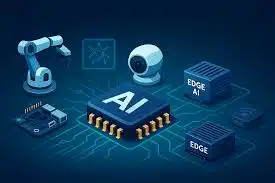- The Rise of Edge AI and On-Device Intelligence
- What is Edge AI?
- Benefits of On-Device Intelligence
- Applications of Edge AI
- The Challenges Ahead
- The Future Landscape in 2025
- Conclusion
The Rise of Edge AI and On-Device Intelligence
As we move closer to 2025, the advancements in technology are set to transform the way devices process data. Edge AI and on-device intelligence are leading this change by shifting the computational power from centralized cloud servers to local devices. This evolution not only promises enhanced performance but also paves the way for increased privacy and reduced latency.
What is Edge AI?
Edge AI refers to artificial intelligence processes that are carried out locally on hardware devices rather than relying on a central cloud server. This localization of operations means that data can be analyzed and acted upon in real-time, making devices smarter while minimizing the amount of information that must be sent to the cloud. With the proliferation of IoT devices, the demand for efficient data processing is greater than ever, and Edge AI provides a viable solution.
Benefits of On-Device Intelligence
-
Enhanced Speed and Efficiency: By processing data on-device, users experience quicker response times. This speed is critical for applications such as autonomous vehicles and smart home devices, where split-second decisions can significantly impact safety and user experience.
-
Improved Privacy and Security: With data being processed locally, sensitive information does not need to leave the device. This reduction in data transmission decreases the risk of breaches and unauthorized access, making it a key consideration for users concerned about privacy.
-
Reduced Bandwidth Costs: Transmitting large amounts of data to the cloud can result in significant costs. On-device intelligence allows for the compression of data or its complete processing on the device, conserving bandwidth and saving users money.
-
Better Reliability: Edge AI can function independently, minimizing reliance on internet connectivity. In areas with poor network coverage, devices can still operate effectively, ensuring continuity in critical services.
Applications of Edge AI
The applications of Edge AI are vast and diverse, spanning various sectors:
-
Healthcare: Wearable devices equipped with Edge AI capabilities can monitor vital signs and provide real-time alerts to healthcare providers, enabling quicker responses and better patient outcomes.
-
Smart Cities: Traffic management systems utilizing Edge AI can analyze real-time data from sensors to optimize traffic flow, reduce congestion, and enhance public safety.
-
Agriculture: Farmers can leverage drones and sensors with on-device intelligence for crop monitoring and management, making timely decisions based on data collected from their fields.
-
Retail: Retailers are increasingly integrating AI-powered cameras and sensors in stores to analyze customer behavior, optimize inventory management, and personalize shopping experiences in real-time.
The Challenges Ahead
Despite the many advantages, the rollout of Edge AI and on-device intelligence is not without its challenges. One significant hurdle is the limited processing power of many consumer devices. Ensuring efficient AI algorithms that can operate within these constraints is crucial for widespread adoption.
Moreover, standardizing protocols for interoperability between devices poses another challenge. As the ecosystem of connected devices continues to grow, developing compatible frameworks will be imperative to maximize the potential of Edge AI.
The Future Landscape in 2025
Looking ahead to 2025, the integration of Edge AI is expected to become ubiquitous across various domains. Machine learning models will become more sophisticated, enabling devices to learn and adapt to user preferences autonomously. Moreover, advancements in hardware will facilitate even more complex computations across various devices, fostering innovation.
As consumers become increasingly aware of data privacy issues, a growing emphasis on local data processing will likely reshape user expectations. Companies that prioritize Edge AI in their product development will not only meet these expectations but will also lead the charge in sustainable, efficient technology.
Conclusion
Edge AI and on-device intelligence are set to redefine our interaction with technology by 2025. As improvements continue to emerge in processing capabilities and machine learning algorithms, the focus will shift to enhancing end-user experiences while maintaining a commitment to privacy and efficiency. The future points toward a reality where intelligent devices operate seamlessly in our everyday lives, fundamentally transforming industries and consumer engagement.
